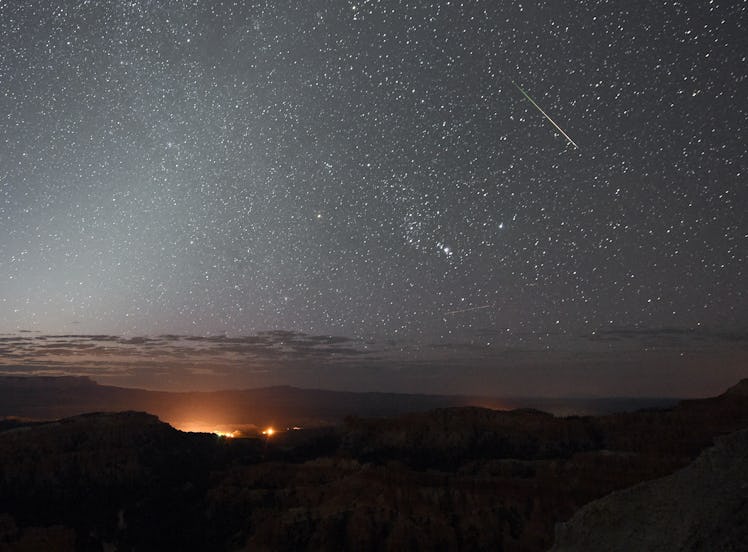
Everything You Need To Know About Catching The Leonids Meteor Shower This Weekend
What up sky-nerds? If you're a fan of astronomy you might have noticed a number of invitations circling the internet for a first row ticket to a celestial event set to take the sky stage this weekend called the Leonids meteor shower. If you didn't know, now you do. So if you're wondering how to see the Leonids meteor shower 2017, we're here to help you figure out all the details. You could even throw a little viewing party.
The Leonids meteor shower is actually a yearly event, as dependable as any holiday like Thanksgiving or Christmas. It comes annually around Nov. 17 or 18. Whenever Earth crosses through the orbital path of a comet called Temple- Tuttle (seriously a very cute name for a comet, amirite?) the debris from the comet enters into our planets atmosphere and creates this celestial fireworks show. It's gorgeous to watch, and this year, there's no moon to draw light away from the view, making it even brighter. Sounds perfect, right? Invite over your friends, or some guy who you're trying to impress with your epic knowledge of meteor showers, and sit down to enjoy the show. Here's everything you need to know to get the best viewing experience of the Leonids Meteor shower of 2017.
The Best Time To View
The Leonids meteor shower is predicted to reach its absolute peak (ahem, it's climax, if you wanna get sexy with it) during the pre dawn hours of Friday, Nov. 17 and 18. That means basically that from midnight to dawn on Friday or Saturday are the best times to watch. If you missed last night, you still have tonight to enjoy the show, because some sources are reporting the peak time to view is Saturday Nov. 18 at 2:00 A.M.
Where To View
As for the best views of the meteor shower, you can always try to get a clear view from the city, but the surrounding light pollution can make it tough to view the stars, let alone a meteor shower. So the best plan is to drive far enough out of the city to go check out the meteors from the side of a highway somewhere in the country. Bring a blanket, a warm ass jacket, and two thermoses of hot chocolate cider or something and cuddle up on the hood to take in the view.
If that doesn't do it for you, you can also check out the best places to stargaze in your city here.
Which Direction Do I Look?
Well, This is a real dumb question, because obviously the answer is "Up, moron," but if you're talking about which direction in the sky, I respect that. You're just trying to cover your bases and be thorough. The simple answer though, is that in all annual meteor showers, the meteors will appear in all parts of the sky, so you won't need the exact coordinates like some kind of astronomical Christopher Columbus.
A Little Backstory To Impress Your Pals
Anyone who has their zodiac sign in Leo will like this, because it's about them: the Leonids Meteor Shower got it's name because the point in the sky they radiate from is the constellation Leo, shooting outward from the lions mane. Again, you won't need to locate the constellation of Leo in the sky in order to view the shower, because you can see the meteors in all parts of the sky. However, if you trace back to the point they're radiating from (also known as the radiant point) you might be able to trace the constellation of Leo in the sky.
Happy viewing!